Tianbo Wang
Ptychographic non-line-of-sight imaging for depth-resolved visualization of hidden objects
May 17, 2024



Abstract:Non-line-of-sight (NLOS) imaging enables the visualization of objects hidden from direct view, with applications in surveillance, remote sensing, and light detection and ranging. Here, we introduce a NLOS imaging technique termed ptychographic NLOS (pNLOS), which leverages coded ptychography for depth-resolved imaging of obscured objects. Our approach involves scanning a laser spot on a wall to illuminate the hidden objects in an obscured region. The reflected wavefields from these objects then travel back to the wall, get modulated by the wall's complex-valued profile, and the resulting diffraction patterns are captured by a camera. By modulating the object wavefields, the wall surface serves the role of the coded layer as in coded ptychography. As we scan the laser spot to different positions, the reflected object wavefields on the wall translate accordingly, with the shifts varying for objects at different depths. This translational diversity enables the acquisition of a set of modulated diffraction patterns referred to as a ptychogram. By processing the ptychogram, we recover both the objects at different depths and the modulation profile of the wall surface. Experimental results demonstrate high-resolution, high-fidelity imaging of hidden objects, showcasing the potential of pNLOS for depth-aware vision beyond the direct line of sight.
PPBFL: A Privacy Protected Blockchain-based Federated Learning Model
Jan 08, 2024Abstract:With the rapid development of machine learning and a growing concern for data privacy, federated learning has become a focal point of attention. However, attacks on model parameters and a lack of incentive mechanisms hinder the effectiveness of federated learning. Therefore, we propose A Privacy Protected Blockchain-based Federated Learning Model (PPBFL) to enhance the security of federated learning and encourage active participation of nodes in model training. Blockchain technology ensures the integrity of model parameters stored in the InterPlanetary File System (IPFS), providing protection against tampering. Within the blockchain, we introduce a Proof of Training Work (PoTW) consensus algorithm tailored for federated learning, aiming to incentive training nodes. This algorithm rewards nodes with greater computational power, promoting increased participation and effort in the federated learning process. A novel adaptive differential privacy algorithm is simultaneously applied to local and global models. This safeguards the privacy of local data at training clients, preventing malicious nodes from launching inference attacks. Additionally, it enhances the security of the global model, preventing potential security degradation resulting from the combination of numerous local models. The possibility of security degradation is derived from the composition theorem. By introducing reverse noise in the global model, a zero-bias estimate of differential privacy noise between local and global models is achieved. Furthermore, we propose a new mix transactions mechanism utilizing ring signature technology to better protect the identity privacy of local training clients. Security analysis and experimental results demonstrate that PPBFL, compared to baseline methods, not only exhibits superior model performance but also achieves higher security.
FBChain: A Blockchain-based Federated Learning Model with Efficiency and Secure Communication
Nov 21, 2023Abstract:Privacy and security in the parameter transmission process of federated learning are currently among the most prominent concerns. However, there are two thorny problems caused by unprotected communication methods: "parameter-leakage" and "inefficient-communication". This article proposes Blockchain-based Federated Learning (FBChain) model for federated learning parameter communication to overcome the above two problems. First, we utilize the immutability of blockchain to store the global model and hash value of local model parameters in case of tampering during the communication process, protect data privacy by encrypting parameters, and verify data consistency by comparing the hash values of local parameters, thus addressing the "parameter-leakage" problem. Second, the Proof of Weighted Link Speed (PoWLS) consensus algorithm comprehensively selects nodes with the higher weighted link speed to aggregate global model and package blocks, thereby solving the "inefficient-communication" problem. Experimental results demonstrate the effectiveness of our proposed FBChain model and its ability to improve model communication efficiency in federated learning.
BRFL: A Blockchain-based Byzantine-Robust Federated Learning Model
Oct 20, 2023Abstract:With the increasing importance of machine learning, the privacy and security of training data have become critical. Federated learning, which stores data in distributed nodes and shares only model parameters, has gained significant attention for addressing this concern. However, a challenge arises in federated learning due to the Byzantine Attack Problem, where malicious local models can compromise the global model's performance during aggregation. This article proposes the Blockchain-based Byzantine-Robust Federated Learning (BRLF) model that combines federated learning with blockchain technology. This integration enables traceability of malicious models and provides incentives for locally trained clients. Our approach involves selecting the aggregation node based on Pearson's correlation coefficient, and we perform spectral clustering and calculate the average gradient within each cluster, validating its accuracy using local dataset of the aggregation nodes. Experimental results on public datasets demonstrate the superior byzantine robustness of our secure aggregation algorithm compared to other baseline byzantine robust aggregation methods, and proved our proposed model effectiveness in addressing the resource consumption problem.
High-throughput lensless whole slide imaging via continuous height-varying modulation of tilted sensor
Sep 28, 2021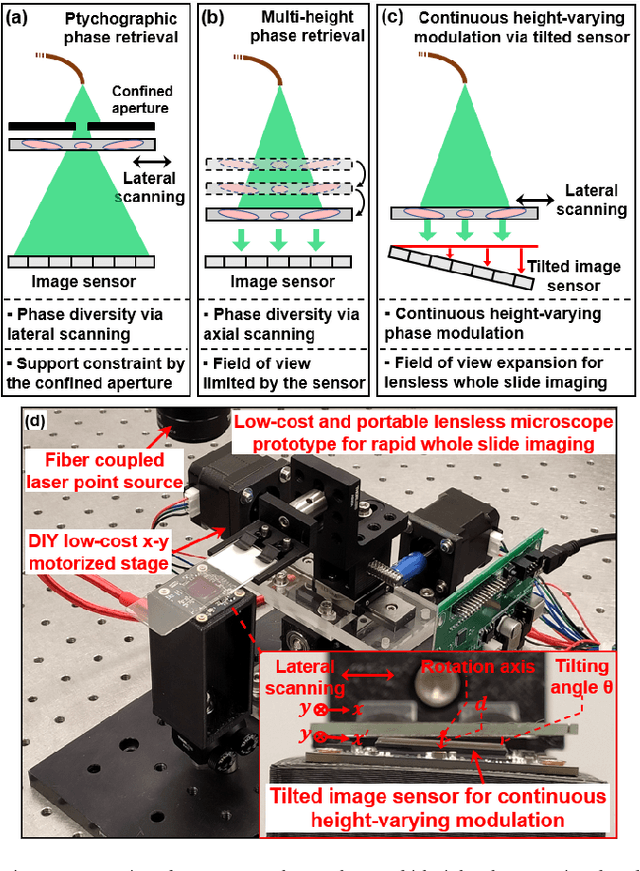
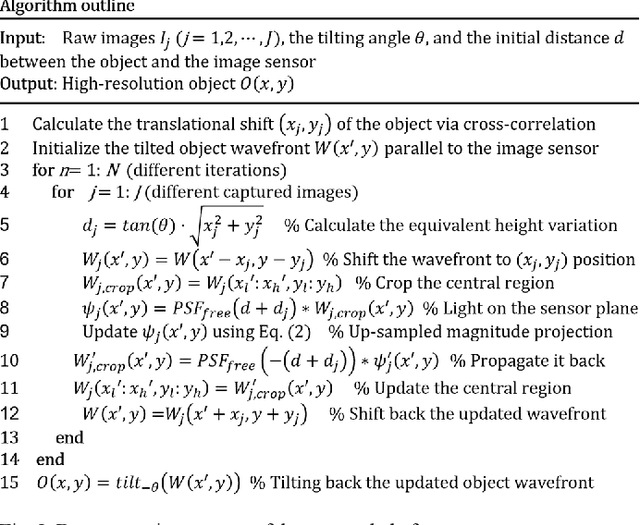

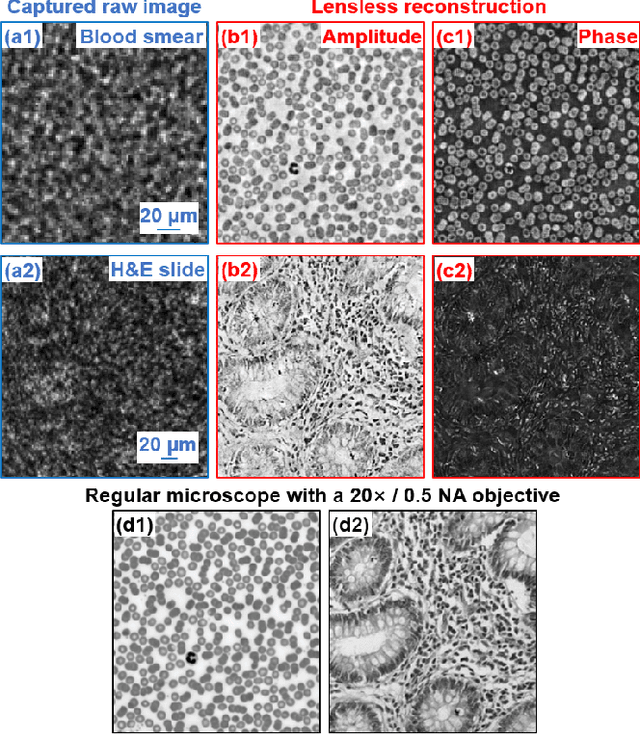
Abstract:We report a new lensless microscopy configuration by integrating the concepts of transverse translational ptychography and defocus multi-height phase retrieval. In this approach, we place a tilted image sensor under the specimen for linearly-increasing phase modulation along one lateral direction. Similar to the operation of ptychography, we laterally translate the specimen and acquire the diffraction images for reconstruction. Since the axial distance between the specimen and the sensor varies at different lateral positions, laterally translating the specimen effectively introduces defocus multi-height measurements while eliminating axial scanning. Lateral translation further introduces sub-pixel shift for pixel super-resolution imaging and naturally expands the field of view for rapid whole slide imaging. We show that the equivalent height variation can be precisely estimated from the lateral shift of the specimen, thereby addressing the challenge of precise axial positioning in conventional multi-height phase retrieval. Using a sensor with a 1.67-micron pixel size, our low-cost and field-portable prototype can resolve 690-nm linewidth on the resolution target. We show that a whole slide image of a blood smear with a 120-mm^2 field of view can be acquired in 18 seconds. We also demonstrate accurate automatic white blood cell counting from the recovered image. The reported approach may provide a turnkey solution for addressing point-of-care- and telemedicine-related challenges.
Bypassing the resolution limit of diffractive zone plate optics via rotational Fourier ptychography
Feb 07, 2021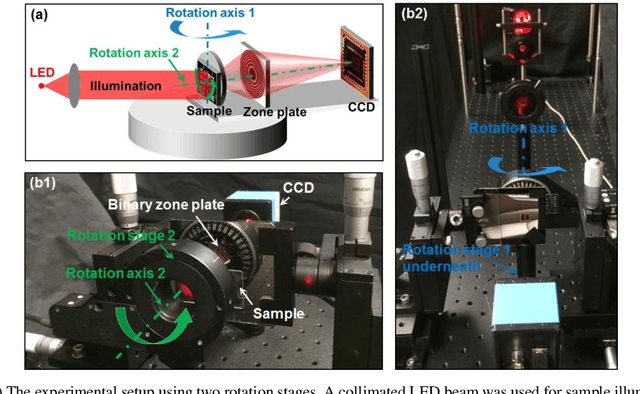
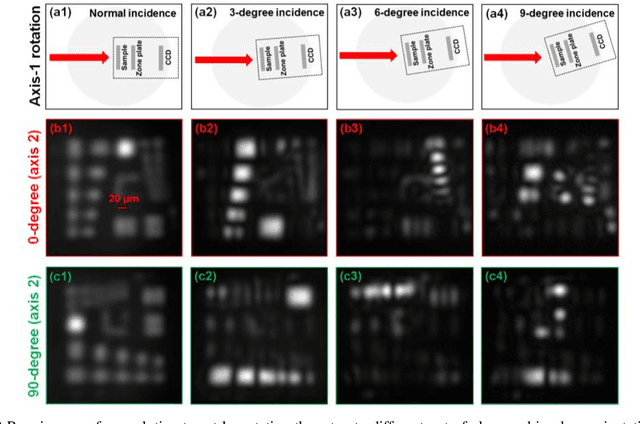
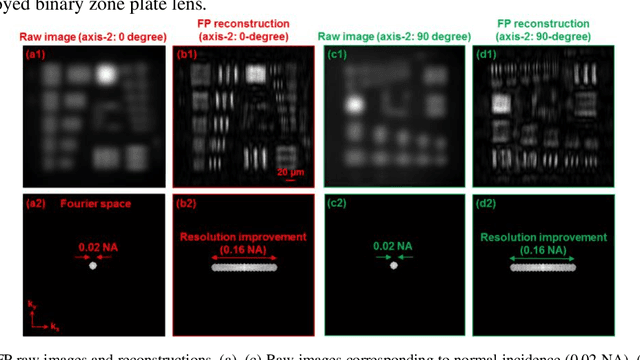
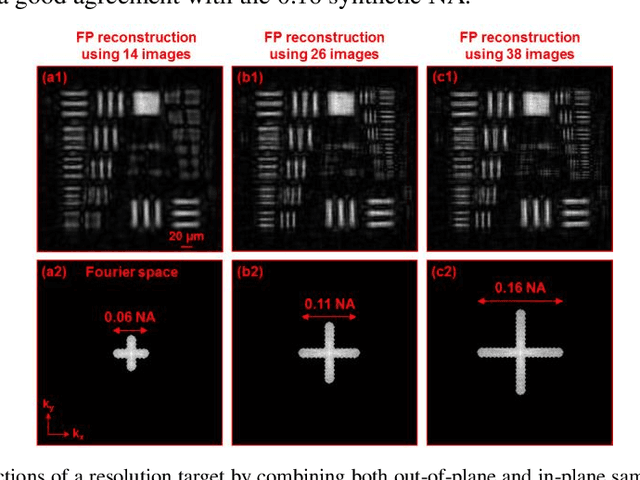
Abstract:Diffractive zone plate optics uses a thin micro-structure pattern to alter the propagation direction of the incoming light wave. It has found important applications in extreme-wavelength imaging where conventional refractive lenses do not exist. The resolution limit of zone plate optics is determined by the smallest width of the outermost zone. In order to improve the achievable resolution, significant efforts have been devoted to the fabrication of very small zone width with ultrahigh placement accuracy. Here, we report the use of a diffractometer setup for bypassing the resolution limit of zone plate optics. In our prototype, we mounted the sample on two rotation stages and used a low-resolution binary zone plate to relay the sample plane to the detector. We then performed both in-plane and out-of-plane sample rotations and captured the corresponding raw images. The captured images were processed using a Fourier ptychographic procedure for resolution improvement. The final achievable resolution of the reported setup is not determined by the smallest width structures of the employed binary zone plate; instead, it is determined by the maximum angle of the out-of-plane rotation. In our experiment, we demonstrated 8-fold resolution improvement using both a resolution target and a titanium dioxide sample. The reported approach may be able to bypass the fabrication challenge of diffractive elements and open up new avenues for microscopy with extreme wavelengths.
 Add to Chrome
Add to Chrome Add to Firefox
Add to Firefox Add to Edge
Add to Edge